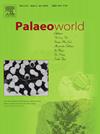First record of Brachyoxylon wood from Upper Jurassic of Sichuan Basin, Southwest China and its paleoenvironmental significance
IF 1.7
3区 地球科学
Q2 PALEONTOLOGY
引用次数: 0
Abstract
Diverse and abundant foliage fossils are well known and well documented from the Upper Triassic to the Lower and Middle Jurassic of the Sichuan Basin in Southwest China. Yet, the fossil record of Upper Jurassic plants in this region is sparse. Decades ago, hundreds of fossil wood specimens were unearthed from the Upper Jurassic in the central part of the Sichuan Basin, offering important insights into the region’s past terrestrial ecosystems and paleoclimate. Despite their significance, systematic studies of these fossils have been limited. Here, we describe the anatomy of a fossil wood specimen from the Upper Jurassic Penglaizhen Formation in Shehong City, Sichuan Province. The specimen displays key Brachyoxylon features, including mixed radial tracheid pitting in conjunction with araucarioid cross-field pitting. This is the first record of the coniferous wood Brachyoxylon in the central Sichuan Basin. Paleoclimatic evidence from associated leaves, pollen, and sediments, suggests that these trees thrived under generally warm and semi-arid to arid conditions, likely in riparian and lacustrine environments with local water abundance, as indicated by the growth rings with narrow latewood bands.
四川盆地上侏罗统短梭梭木的首次记录及其古环境意义
四川盆地上三叠统至下侏罗统、中侏罗统的叶类化石种类繁多,文献记载丰富。然而,该地区上侏罗世植物的化石记录很少。几十年前,四川盆地中部的上侏罗世出土了数百块木材化石标本,为了解该地区过去的陆地生态系统和古气候提供了重要的见解。尽管它们意义重大,但对这些化石的系统研究还很有限。本文描述了四川射洪市上侏罗统蓬莱镇组的一个木材化石标本的解剖结构。该标本显示了短梭梭的主要特征,包括混合的径向管胞点蚀和araucarioid交叉点蚀。这是四川盆地中部首次记录到的针叶林短梭梭。来自相关叶片、花粉和沉积物的古气候证据表明,这些树木在普遍温暖和半干旱到干旱的条件下生长,可能是在当地水丰富的河岸和湖泊环境中生长,正如生长年轮与狭窄的晚木带所表明的那样。
本文章由计算机程序翻译,如有差异,请以英文原文为准。
求助全文
约1分钟内获得全文
求助全文
来源期刊

Palaeoworld
PALEONTOLOGY-
CiteScore
4.00
自引率
5.90%
发文量
95
期刊介绍:
Palaeoworld is a peer-reviewed quarterly journal dedicated to the study of past life and its environment. We encourage submission of original manuscripts on all aspects of palaeontology and stratigraphy, comparisons of regional and global data in time and space, and results generated by interdisciplinary investigations in related fields. Some issues will be devoted entirely to a special theme whereas others will be composed of contributed articles. Palaeoworld is dedicated to serving a broad spectrum of geoscientists and palaeobiologists as well as serving as a resource for students in fields as diverse as palaeobiology, evolutionary biology, taxonomy and phylogeny, geobiology, historical geology, and palaeoenvironment.
Palaeoworld publishes original articles in the following areas:
•Phylogeny and taxonomic studies of all fossil groups
•Biostratigraphy, chemostratigraphy, chronostratigraphy
•Palaeoecology, palaeoenvironment and global changes throughout Earth history
•Tempo and mode of biological evolution
•Biological events in Earth history (e.g., extinctions, radiations)
•Ecosystem evolution
•Geobiology and molecular palaeobiology
•Palaeontological and stratigraphic methods
•Interdisciplinary studies focusing on fossils and strata
 求助内容:
求助内容: 应助结果提醒方式:
应助结果提醒方式:


